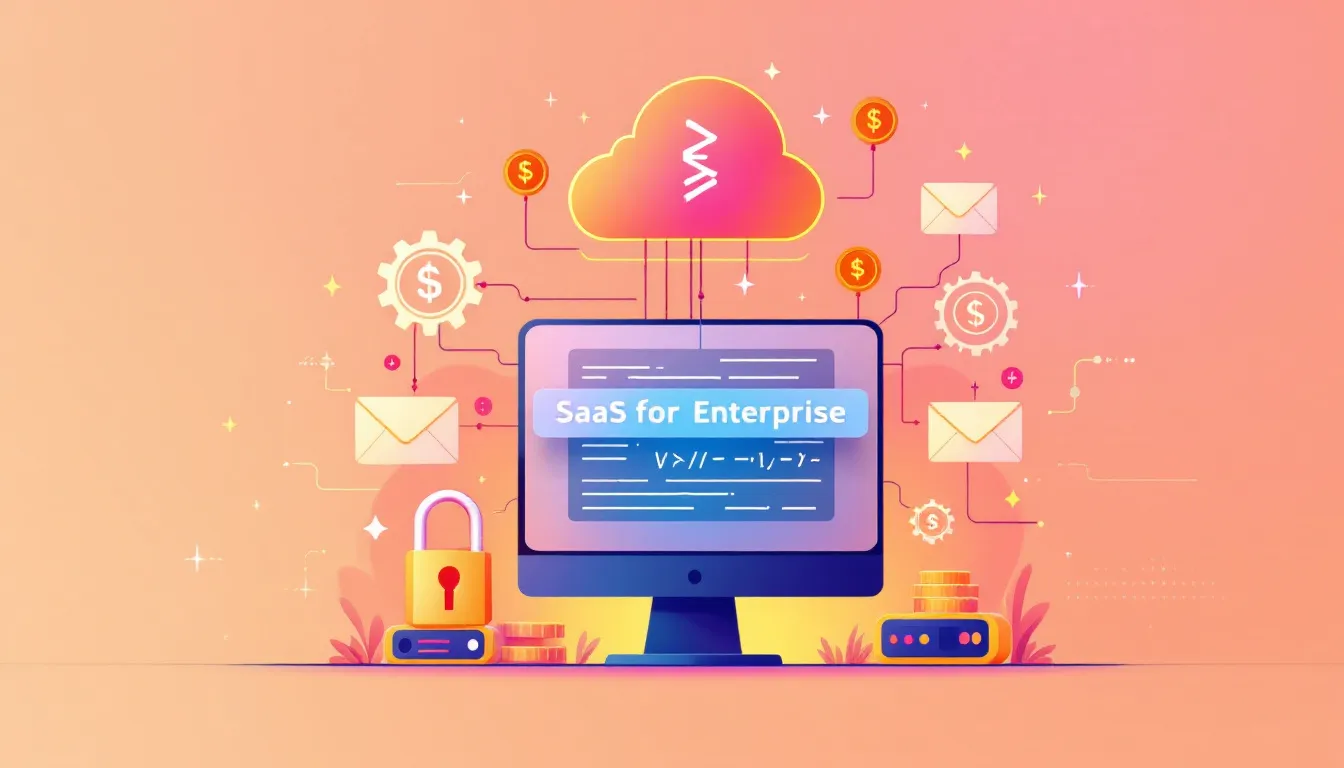
SaaS enterprise solutions have revolutionized how businesses operate, offering unmatched efficiency and scalability. With SaaS adoption rates soaring from 71% in 2018 to 95% in 2023, enterprises increasingly rely on these tools to streamline processes and reduce operational complexity. The average number of SaaS applications enterprises use has also grown significantly, reaching 473 in 2023.
You might want to consider SaaS for enterprises if you face challenges in managing large-scale operations, such as ensuring data security, maintaining compliance, and integrating diverse systems.
SaaS for enterprises addresses these issues with built-in compliance features, robust security protocols, and seamless integration capabilities. These solutions also support enterprise digital transformation by enabling real-time collaboration and enhancing accessibility for global teams. Today’s B2B SaaS market leaves no room for businesses that ignore SaaS. It’s crucial for digital transformation, resource optimization, and maintaining a competitive advantage.
Understanding SaaS for Enterprise
What Is SaaS?
SaaS adoption rates, soaring from 71% in 2018 to 95% in 2023, is a modern approach to delivering enterprise software. Unlike traditional software that requires installation on physical hardware, SaaS operates as a cloud-based software delivery model. You access applications over the internet, eliminating the need for on-premises infrastructure.
This model offers subscription-based access, allowing you to pay only for what you use. Several characteristics set SaaS apart from traditional software models:
-
Customization and Integration: SaaS platforms provide high levels of customization and seamless integration with other tools, enhancing productivity.
-
Security Management: Providers handle security, reducing your responsibility for managing vulnerabilities.
-
Maintenance and Updates: Automatic updates ensure your enterprise software remains current without manual intervention.
This delivery model supports enterprise digital transformation by simplifying operations and enabling you to focus on innovation rather than IT maintenance.
Why SaaS Is Essential for Enterprises
Enterprise SaaS has evolved to meet the unique demands of large-scale operations. Traditional enterprise solutions often required significant upfront investments and complex implementations.
SaaS revolutionized this by offering a cost-effective and adaptable alternative.
Here’s why SaaS is critical for enterprises:
-
Meeting Operational Demands: SaaS automates routine tasks like email marketing and data management, freeing your team to focus on strategic goals. It simplifies workflows and enhances collaboration across departments.
-
Supporting Security and Compliance: SaaS providers implement robust security measures, including encryption and access controls, to protect sensitive data. They also ensure compliance with regulations like GDPR and HIPAA, reducing your risk of penalties.
The scalability and accessibility of SaaS enterprise solutions make them indispensable for businesses navigating digital transformation. Whether you manage a hybrid workforce or global teams, SaaS ensures your operations remain agile and efficient.
Key Benefits of Enterprise SaaS Solutions
Cost Efficiency
Reducing hardware and maintenance expenses
Enterprise SaaS solutions eliminate the need for costly on-premises infrastructure. Traditional software often requires significant upfront investments in hardware, servers, and IT support.
SaaS, on the other hand, operates on a subscription model, reducing these capital expenditures. Providers handle maintenance and updates, saving you from ongoing costs associated with system upkeep.
This approach lowers expenses and frees up resources for strategic initiatives.
Flexible subscription pricing models
The subscription-based nature of SaaS offers financial flexibility. You can choose plans tailored to your enterprise’s needs, scaling up or down as required. This pay-as-you-go model ensures you only pay for what you use, making it easier to manage budgets.
While subscription costs can accumulate over time, the total cost of ownership often remains lower compared to traditional software, especially when factoring in reduced maintenance and upgrade expenses.
Scalability and Flexibility
Adapting to evolving business needs
Enterprise SaaS solutions are designed to grow with your business. Whether you’re expanding into new markets or adjusting to fluctuating demands, SaaS provides the agility needed to adapt. Its cloud-based nature allows you to add or remove users, integrate new features, and scale resources without significant infrastructure changes.
Such flexibility ensures your enterprise remains competitive in a dynamic market.
Seamless support for organizational growth
SaaS for enterprise supports growth by streamlining operations and enhancing efficiency. Automated workflows and data-driven decision-making enable you to focus on innovation rather than administrative tasks.
Tools like Asana and Trello help teams stay organized, while platforms like Google Workspace facilitate real-time collaboration. These capabilities allow your enterprise to scale operations effectively without compromising productivity.
Enhanced Collaboration
Real-time communication and centralized workflows
Modern enterprise SaaS solutions integrate communication, project management, and file-sharing tools into a single platform. This centralization enhances transparency and ensures everyone stays aligned.
Tools like Slack and Microsoft Teams enable instant messaging and video calls, while platforms like Box and ShareFile simplify document sharing. These features foster real-time collaboration, accelerating decision-making and boosting efficiency.
Supporting hybrid and global teams
SaaS platforms empower hybrid and globally distributed teams by providing access to tools from any device, anywhere. Integration with platforms like Google Workspace ensures seamless access to emails, calendars, and documents.
This accessibility enhances productivity, with studies showing a 20-25% boost in efficiency for remote teams. By enabling effective communication and knowledge sharing, SaaS ensures your teams remain connected and productive, regardless of location.
Advanced Accessibility
Remote access to enterprise software and data
Enterprise SaaS solutions redefine how you access critical tools and data. With these platforms, you can log in from any device, at any time, as long as you have an internet connection. This capability eliminates the need for physical office setups, allowing you to work seamlessly from home, a co-working space, or even while traveling.
Remote access ensures that your team remains productive outside traditional office hours. Employees can complete tasks faster, respond to urgent requests, and collaborate on projects without delays. SaaS platforms also integrate automation features, reducing repetitive tasks and enabling your team to focus on high-priority objectives.
For example, tools like Trello and Asana streamline task management, while Slack facilitates instant communication. These features create a virtual office environment, ensuring your operations run smoothly regardless of location.
Enabling productivity across distributed teams
Enterprise SaaS solutions empower distributed teams by providing centralized access to essential tools. Whether your workforce operates in different time zones or adopts a hybrid model, these platforms ensure everyone stays connected.
Employees can share files, assign tasks, and brainstorm ideas in real time, fostering collaboration across departments.
SaaS for enterprise enhances flexibility by allowing employees to work from various locations without compromising efficiency. Platforms like Google Workspace and Microsoft Teams integrate communication, project management, and file-sharing tools, enabling seamless cross-departmental collaboration.
This accessibility boosts productivity, with studies showing that remote teams using SaaS tools experience a 20-25% increase in efficiency.
Automation features further enhance productivity by streamlining workflows and reducing manual effort. For instance, CRM software integrated with project management tools ensures that your sales and marketing teams work in sync. These capabilities make enterprise SaaS solutions indispensable for managing distributed teams and maintaining operational excellence in the competitive B2B SaaS market.
Strategies for Implementing Enterprise SaaS Effectively
Seamless Integration
Ensuring compatibility with existing enterprise software
Integrating enterprise SaaS solutions with your existing enterprise software requires careful planning. Start by identifying your integration needs. Determine which business processes need connecting and what data must flow between systems. Create a strategy that prioritizes compatibility, ensuring your SaaS tools align with your current workflows.
Testing before launch is essential to confirm that data transfers correctly and workflows function as expected. Regular monitoring and maintenance will help you address issues promptly and maintain smooth operations.
Leveraging APIs for smooth data exchange
APIs play a critical role in achieving seamless integration. They enable smooth data exchange between your enterprise SaaS solutions and other systems. Use middleware to bridge gaps between incompatible platforms. Standardize data formats to simplify integration and reduce errors.
Continuous monitoring of API performance ensures optimal functionality, while caching and load balancing improve efficiency. Implementing strong security measures, such as encryption and OAuth2 authentication, protects sensitive data during transfers.
Customization and Personalization
Tailoring SaaS solutions to enterprise-specific needs
Enterprise SaaS solutions offer extensive customization options to meet your unique requirements. Tailoring these solutions allows you to adapt them to specific business functions, ensuring they align with your operational goals. For example, custom dashboards and workflows can enhance productivity by providing teams with tools designed for their tasks.
This level of personalization ensures your enterprise software evolves alongside your business needs.
|
Benefit |
Description |
|---|---|
|
Tailoring |
Adapt solutions to specific business needs. |
|
Scalability |
Adjust services as your enterprise grows. |
|
Enhanced Customization |
Exceed traditional software capabilities with modular features. |
|
Brand Integration |
Incorporate unique functionalities and brand elements. |
Utilizing modular features for flexibility
Modular features in enterprise SaaS solutions enhance flexibility by offering micro-solutions tailored to specific needs. These features allow you to scale services as required, fostering innovation and operational efficiency.
For instance, you can integrate additional functionalities or unique brand elements without overhauling the entire system. This adaptability ensures your enterprise solutions remain relevant and effective.
Employee Training and Engagement
Comprehensive onboarding programs
A successful onboarding program ensures employees can use enterprise SaaS solutions effectively. Simplify the process with features like single sign-on and action-focused product tours. Highlight how the tools solve user problems rather than just providing tutorials.
Strategic emails and user-centric language can guide employees through setup and help them achieve their goals quickly.
|
Key Component |
Description |
|---|---|
|
Easy Sign-Up |
Simplify the process to avoid user drop-off. |
|
Action-Focused Tours |
Highlight features solving user problems. |
|
Desired Outcomes |
Help users achieve goals from the start. |
|
Strategic Emails |
Send emails based on user actions to encourage progression. |
Encouraging adoption through ongoing support
Sustaining employee engagement with enterprise SaaS requires continuous effort. Regular updates from SaaS providers keep tools current and effective. Analytics from these platforms help you track engagement and refine strategies. High levels of customization allow you to tailor tools to your organizational culture, improving adoption rates.
Seamless integration with other systems also creates a unified experience, making it easier for employees to stay engaged.
Addressing Challenges in Enterprise SaaS Adoption
Ensuring Data Security and Compliance
Adhering to industry regulations and standards
Maintaining compliance with industry regulations is critical when adopting enterprise software. SaaS providers often include built-in compliance features to help you meet standards like GDPR, HIPAA, or SOC 2.
However, you must ensure these solutions align with your enterprise digital transformation goals. A lack of clear ownership for SaaS security can lead to oversight issues. Many enterprises struggle with misconfigurations or configuration drift, which increases risks.
|
Challenge Type |
Description |
|---|---|
|
Rapid Shift to SaaS |
Enterprises often adopt SaaS quickly without adequate data protection measures. |
|
Evolution of SaaS Platforms |
Security tools lag behind the rapid advancements in SaaS platforms. |
|
Misconfiguration and Configuration Drift |
Inconsistent security settings across applications create vulnerabilities. |
|
Risks from Third-party Applications |
Connecting multiple third-party apps increases functionality but also security risks. |
|
Lack of Clear Ownership for SaaS Security |
Undefined roles lead to gaps in accountability and oversight. |
Implementing encryption and secure access protocols
Encryption and secure access protocols are essential for protecting sensitive data. SaaS providers often implement advanced encryption methods to safeguard information during storage and transmission.
Secure access protocols, such as multi-factor authentication and OAuth2, prevent unauthorized access. These measures not only enhance data security but also ensure compliance with regulatory standards, reducing legal risks.
Avoiding Vendor Lock-In
Selecting providers with flexible contracts
Vendor lock-in can limit your ability to adapt to changing business needs. To avoid this, select SaaS providers offering flexible contracts with clear exit clauses. Negotiate terms that allow you to retrieve your data easily and transition to other platforms without disruptions.
Regularly assess your providers to identify early signs of lock-in and maintain control over your enterprise software.
Prioritizing interoperability and data portability
Interoperability and data portability are crucial for avoiding dependency on a single vendor. Use open-source standards to ensure your applications and data remain adaptable. Design your processes to accommodate future technology environments.
Keeping your data portable simplifies transitions between SaaS providers, supporting your enterprise digital transformation efforts.
Managing Costs Effectively
Monitoring usage to optimize spending
Monitoring SaaS usage helps you control costs and align spending with organizational goals. Use spend management tools to track expenses in real time. Conduct audits to identify underutilized applications and negotiate better pricing terms.
Allocating budgets based on departmental needs prevents overspending and efficiently uses resources.
Regularly reviewing and adjusting subscription plans
Annual reviews of your SaaS subscription plans are essential for managing costs effectively. This practice aligns with financial planning cycles and helps you adapt to market conditions.
Regular adjustments ensure your enterprise remains competitive while maintaining client satisfaction. Monitoring competitor pricing also allows you to negotiate favorable terms with your SaaS providers.
Enterprise SaaS solutions have transformed how you manage operations, offering adaptability, scalability, and cost-efficiency. These tools streamline processes, automate workflows, and provide seamless integration with existing systems. They also ensure your teams can collaborate effectively, regardless of location, while maintaining robust security and compliance.
Strategic implementation is essential for maximizing these benefits.
Focus on tailoring solutions to your needs, integrating them seamlessly, and addressing challenges like data security and vendor lock-in proactively. Regular assessments and employee training further enhance adoption and efficiency.
Exploring SaaS solutions equips your enterprise with cutting-edge tools to stay agile in a fast-paced market. Embracing this technology ensures you remain competitive, future-proof your operations, and foster innovation.


